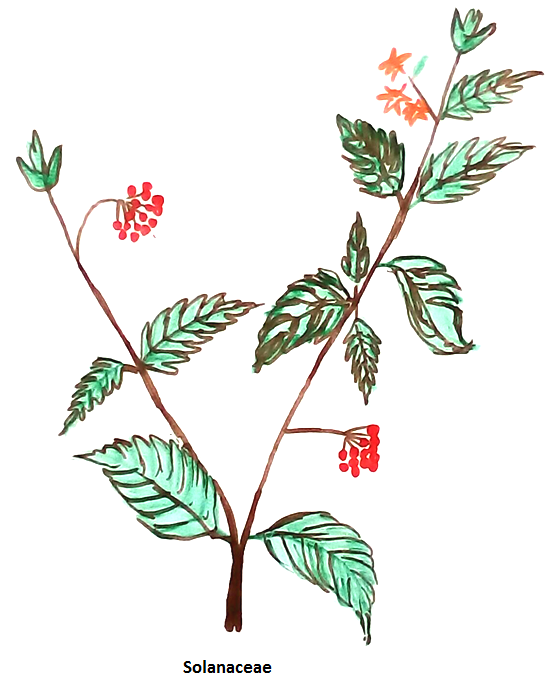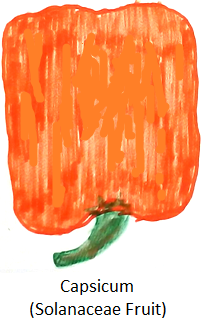Solanacaea Family
Solanaceae is a flowering plant. Solanacaea are called night shade plant. The term solanum derived from Greek word which means night shade plant. Solanacaea plants are distributed all over the world except Antarctica. They are 98 genera and about 2700 species in the world. Major variations are found in North America and Central America. The most economical important plant of Solanacaea family is Tuberosum (potatoes).
Salient features of Solanacaea are following:
1. Plants of this family are herbs, shrubs, lianas or small trees.
2. They have internal phloem in vascular bundles around pith.
3. They contain branches hairs or often pickles.
4. This plant contains various alkaloids like nicotine, atropine, belladona etc.
5. Leaves are spirally arranged with simple, pinnately compound or trifoliate which are lacking of stipules.
6. In this family inflorescence determinate are sometimes reduced to a single flower.
7. Flowers are usually bisexual and regular in shape. They may be androecious, monoecious or dioecious.
8. Calyx contains five sepals,connate persistence which are sometimes enlarging with the fruits.
9. Corolla are of usually five petals connate rotate or tubular with lobes usually plicated (sometimes convulate) in bud, sometimes imbricate or valvate. Flowers can be solitary, grouped into cymose or axilary inflorescence.
10. Androecium contains five stamens, usually alternating with the petals and filaments epipetalous attached to a tube, anthers usually bi locular open by longitudinal slit or open with terminal pores.
11. Pollen grains usually trip or penta colpate or colporate.
12. Gynoecium are usually of two carpels oriented diagonally in flower, connate usually a disc around the gynoecium.
13. Ovary is superior and axile placentation is observed.
14. Two locules (upto five) with one anatropous to hemianatropous or amphitropous unitegmic ovule in each locules.
15. Styles are terminals, sometimes gynobasic, stigma mostly of them are three lobed.
16. Fruits are usually a berry or septicidal capsule.
17. Seeds are often flattened with straight or curved embryo.
18. This family contains oily and proteinaceous endosperm.
Different sub classes are observed in this category. They are –
Cestroideae
Geotzioideae
Nicotinoideae
Petunioideae
Schwenckioideae
Solanoideae
Economic importance of the family Solanacaea:
Used as vegetables –Potatoes (Solanum tuberosum), brinjal (S. melongena), tomatoes (S. lycopersicum), green peppers (Capsicum spp).
Used as medicinal plants –some plants of this familyalso have medicinal importance. Examples – belladonna yield atropine which is extracted from Atropa belladona. Henbane is extracted from Hyoscyamus niger. Brugmansia sanguinea.
Used as ornamental purpose- some plants are used as ornamental purpose. Examples night blooming jesmine (Cestrum nocturnum), Petunia sp, of the night or yesterday-today-tomorrow (Brunfelsia australis).
Nicotinamide – Plant species produce nicotine which is derived from tobacco.
Question and Answer on Solanacaea Family:
1. Name a tree member of Solanacaea.
Answer:
Solanum erianthum, S. America.
2. Name two climbing plant of Solanacaea.
Answer:
Solanum dulcamara, Lycium chinense.
3. Name two plants of Solanacaea with irregular flowers.
Answer:
Salpiglossis sinuata, Schizanthus pinnatus, Brunfelsia australis.
4. Which plant of Solanacaea is known as yesterday-today-tomorrow?
Answer:
Flower of this plant fade from purple to white with time. Name of the flower is Brunfelsia australis.
From Solanacaea Family to HOME PAGE
Recent Articles
-
What Is Plasma? | Blood Plasma | Proteins | Nutrients | Cholesterol
Nov 07, 25 10:29 AM
Blood is a mobile fluid which is a connective tissue and is derived from the mesoderm like cell any other connective tissue. Colour of blood is reddish and that flows inside the blood vessels by means… -
Disorders of Respiratory System | Tuberculosis | Pleurisy | Emphysema
Oct 28, 25 11:39 PM
Tuberculosis is very common disease and is caused by a type of bacteria called Mycobacterium tuberculosis. This disease causes different trouble in the respiration and infection of several parts of th… -
Regulation of Respiration | Respiratory Centres | Inspiratory Area |
Oct 14, 25 12:13 AM
Respiratory Centre is the area that controls the rate of respiration and it is observed to be located in medulla oblongata and pons. Respiratory Centre has the following will dispersed components like… -
Explain Transport of Gases | External Respiration | Tissue Respiration
Oct 09, 25 11:35 PM
In humans gaseous exchange is completed in the following ways the steps are - External Respiration or Breathing - Breathing in false taking in of Oxygen and giving out of carbon dioxide in the body. M… -
Kind and Number of Teeth | Location of Teeth in Mouth | Care of Teeth
Sep 11, 25 12:52 AM
Kind and Number of Teeth







New! Comments
Have your say about what you just read! Leave me a comment in the box below.